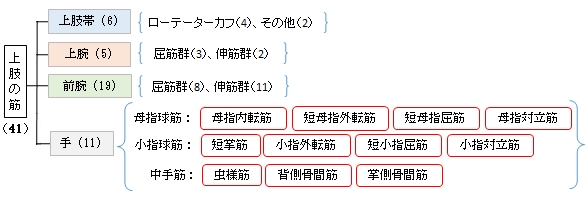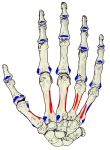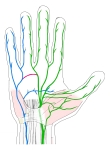背側骨間筋(手) ( はいそくこつかんきん、英語:dorsal interossei (muscles) )
・ 概 要 |
・ 作 用 |
・ イラスト掲載サイト |
|
・ イラスト |
・ 神経 / 脈管 |
||
・ 起始 / 停止 |
・ Wikipedia |
![]()



以下はWikipediaの解説の一部を箇条書きにしたものになる。
1. 第1背側骨間筋が最も大きく、その2頭の間を橈骨動脈が貫通している。
2. 第2~第4背側骨間筋の2頭の間を深掌動脈弓からの枝が貫通している。
3. 第1背側骨間筋は基節骨の近位部に停止するが、それ以外は近位部および遠位部の2種類の停止部がある。
4. 小指外転筋は第5背側骨間筋のような働きをする。
「日本人体解剖学」には以下のような解説文が見られる。
「背側・掌側骨間筋は互いに指を離したり近づけたり作用があり、ともに尺骨神経の支配をうける。尺骨神経の障害により、この運動は不能となる。また、同一指に属するものは、協同してその基節を曲げ、中節と末節を伸ばす働きがある。 」
また、「船戸和也のHP」では以下のように解説している。
「背側骨間筋は、それぞれ2頭が2つの中手骨の相対する面で起こり、第2、第3および第4指の指背腱膜に放散する。2個の背側骨間筋が第3指に付く。背側の腱は第2指では橈側から、第4指では橈側から指背腱膜に入る。」
![]()
![]()
【 起 始 】 : 第1~第5中手骨の向かい合っている側面
【 停 止 】 : 第2~第4基節骨の骨底、一部は指背腱膜に合する。
 |
![]()
・第2指及び第3指を橈側方に引き、第3及び第4指を尺側方に引く。 ⇒ イラスト解説
( じゃんけんのパーのように指を開く働きをする。逆に指を閉じる働きをするのが掌側骨間筋 )
![]()
・ 神 経 : 尺骨神経掌枝の深枝(C8,Th1)
・ 脈 管 : 深掌動脈弓
In human anatomy, the dorsal interossei (DI) are four muscles in the back of the hand that act to abduct (spread) the index, middle, and ring fingers away from hand's midline (ray of middle finger) and assist in flexion at the metacarpophalangeal joints and extension at the interphalangeal joints of the index, middle and ring fingers.
【Structure】
There are four dorsal interossei in each hand. They are specified as 'dorsal' to contrast them with the palmar interossei, which are located on the anterior side of the metacarpals.
The dorsal interosseous muscles are bipennate, with each muscle arising by two heads from the adjacent sides of the metacarpal bones, but more extensively from the metacarpal bone of the finger into which the muscle is inserted. They are inserted into the bases of the proximal phalanges and into the extensor expansion of the corresponding extensor digitorum tendon. The middle digit has two dorsal interossei insert onto it while the first digit (thumb) and the fifth digit (little finger) have none. Each finger is provided with two interossei (palmar or dorsal), with the exception of the little finger, in which the abductor digiti minimi muscle takes the place of one of the dorsal interossei.
The first dorsal interosseous muscle is larger than the others. Between its two heads, the radial artery passes from the back of the hand into the palm. Between the heads of dorsal interossei two, three, and four, a perforating branch from the deep palmar arch is transmitted.
【 語 句 】
・ abduct : 外転させる ・ flexion : 屈曲 ・ metacarpophalangeal joints : 中手指節関節 ・ extension : 伸展 ・ interphalangeal joints : 指節間関節 ・ palmar interossei : 掌側骨間筋 ・ metacarpal : 中手骨 ・ bipennate : 双翼状 ・ adjacent : 隣接する ・ extensively : 広範囲に渡って ・ proximal phalange : 基節骨 ・ extensor expansion : 指背腱膜 ・ extensor digitorum : 総指伸筋 ・ abductor digiti minimi : 小指外転筋 ・ deep palmar arch : 深掌動脈弓
【Origins and insertions】
|
Origin |
Insertion |
first |
on the radial side of the second metacarpal and the proximal half of the ulnar side of the first metacarpal |
on the radial side of the base of the second proximal phalanx (index finger) and the extensor expansion |
second |
on the radial side of the third metacarpal and the ulnar side of the second metacarpal |
on the radial side of the third proximal phalanx (the middle finger) and the extensor expansion |
third |
on the radial side of the fourth metacarpal and the ulnar side of the third metacarpal |
on the ulnar side of the third proximal phalanx (the middle finger) and the extensor expansion |
fourth |
on the radial side of the fifth metacarpal and the ulnar side of the fourth metacarpal |
on the ulnar side of the fourth proximal phalanx (the ring finger) and the extensor expansion |
【Proximal and distal interossei】
With some individual variations, the interossei muscles are attached either proximally or distally on the extensor expansion. The first dorsal interosseous, the most consistent, is inserted entirely into the base of its proximal phalanx and the extensor hood there. The second, third, and fourth dorsal interossei have insertions both proximally on the base of the metacarpal and hood, and distally on the lateral bands and central tendon of the extensor mechanism. The abductor digiti minimi, effectively the "fifth dorsal interosseus" or the dorsal interosseus of the little finger, has only a proximal insertion. The palmar interossei, in contrast, have only distal insertions. The interossei can, thus, be divided into a proximal and a distal group: the proximal interossei are mainly affecting the metacarpophalangeal (MP) joints, whereas the distal interossei are mainly affecting the interphalangeal (IP) joints (but, with continued action, will also affect the MP joints.)
【Innervation】
All interosseous muscles of the hand, with the exception of the first and second lumbricals (the most radial two are innervated by the median nerve), are innervated by the deep branch of the ulnar nerve.
【 語 句 】
・ radial : 橈骨の ・ proximal : 近位の ・ ulnar : 尺骨の ・ proximal phalanx : 基節骨 ・ consistent : 首尾一貫した ・ lumbricals : 虫様筋 ・ ulnar nerve : 尺骨神経
【Function】
The dorsal interossei abduct the index, middle, and ring fingers. The first dorsal interosseous is also able to rotate the index finger slightly at the metacarpophalangeal joint and assist adductor pollicis in thumb adduction.
Metacarpophalangeal joint flexion
All interossei pass dorsal to the transverse metacarpal ligament but slightly volar to the flexion-extension axes of rotation of the MP joints. In effect, their ability to flex at the MP joints will depend on the position of the MP joints:[3]
When the MP joints are extended, all interossei pass through the flexion-extension axes of the MP joints and their contribution there is therefore negligible, though they still play important roles as joint stabilizers (i.e. preventing MP hyperextension). At the same time, the interossei (and abductor digiti minimi) lie relatively far from the anterior-posterior axis of the MP joints and are consequently effective abductors and adductors during MP extension. Because the dorsal interossei are predominantly in the proximal group they are more effective at the MP joints than the palmar interossei and, therefore, abduction is stronger than adduction at the MP joints.
When the MP joints are being flexed, the position of the interossei moves away volarly from the flexion-extension axes of the MP joints until they are nearly perpendicular to the proximal phalanx. At the same time, the increasingly taut collateral ligaments of the MP joints cancel out the abduction-adduction component to increase the force of flexion (resulting in a strong grip). At full flexion, the transverse metacarpal ligament restricts the interossei.
Interphalangeal joint extension
When the MP joints are extended, effective IP joint extension can be achieved by all interossei in the distal group (i.e. all except the two outermost muscles, the first interosseus and abductor digiti minimi) because they are attached directly to the extension mechanism. This IP extension is therefore stronger than MP abduction/adduction which is produced by continued action except for the index and little fingers.
When the MP joints are flexed, the transverse metacarpal ligament enhances the function of the distal interossei by acting as a pulley and preventing them from becoming slack, further increasing the effectiveness of IP extension.
【 語 句 】
・ adductor pollicis : 母指外転筋 ・ transverse metacarpal ligament : 深横中手靭帯? ・ volar : 手掌の ・flexion-extension axes : ? ・ negligible : 無視してよい ・ consequently : 従って ・ predominantly : 主として ・ taut : ピンと張られた ・ cancel out : 相殺する ・ restrict : 制限する ・ enhance : 高める ・ pulley : 滑車 ・ slack : ゆるい
![]()







